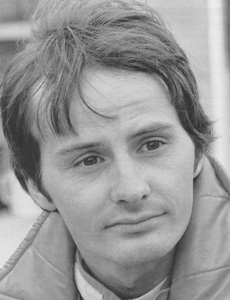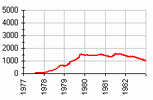Гонщики, V | |
Villeneuve, Gilles Курсивом отмечены гонщики, |
| Жиль ВильнёвVilleneuve, GillesVilleneuve, Joseph Gilles Henri |
 (c) 'Who is Who' by Steve Small, 2000 Родился: 18.01.1950 Сен-Жан-сюр-Ришелье, Шабли, Квебек Умер: 08.05.1982 трасса Зольдер, Бельгия Сезонов в Ф1: Лет в Ф1: 6 Гран При: Старты: 67* *не стартовал: 2 Победы: - подряд: 2 Подиумы: - подряд: 3 Поул-позиции: - подряд: Первый ряд: - подряд: Быстрые круги: - подряд: 4 Лучший финиш: Лучший старт: 1 Дубли: Хет-трики: 1 Лидирование старт/финиш: Большие шлемы: |
Год | Команда | Шасси |
To this day opinions are sharply divided about Gilles Villeneuve. To many he was simply what motor racing was all about. To the more dispassionate he was an accident waiting to happen, and when the end came, well, they were proved right weren't they?
In soccer, if the ball goes to a Pele or Best, or now Giggs, there is a collective sense of anticipation, a feeling that something special could be about to happen ... It was like that with Gilles. As an ordinary punter denied access to the inner sanctum of pit or paddock, you could stand on any corner, at any circuit and wait for his Ferrari to scream into view. Then came the reward. With a glint of wildness in his eyes, and the car at some wicked angle - more often than not at its very limit and then some - Villeneuve would pass and you could sense the thrill.
Gilles raced snowmobiles for several years and tried drag racing before turning to Formula Ford in 1973. Winning seven out of ten races seemed to indicate that a move into Formula Atlantic would be needed to test his powers, but he was soon sidelined, but only for a month, by a fractured leg sustained in an accident at Mosport. Once back in the groove, he started to be noticed, especially after a race at Trois Rivières in 1976 when James Hunt, no less, was soundly thrashed. Typically James told McLaren to sign this man up as soon as possible. The following July, the French-Canadian was in a McLaren - at Silverstone - but for only one race. He was to make the most of it, indulging in countless spins, which to most onlookers seemed to indicate he was in over his head. Gilles knew better; he was just finding the limits in a Grand Prix car and the only way to do that was to go up to and beyond the point of adhesion. Amazingly, Teddy Mayer felt that he could pass on Villeneuve, and so he was picked up by Ferrari. It could all have ended after just two races, for at Fuji he ran into the Tyrrell of Ronnie Peterson and his car somersaulted wildly into a prohibited area, killing two spectators. This time Gilles walked away...
He was to be involved in a string of shunts at the start of 1978, some of his own making, some not. But he was undoubtedly quick and as the year wore on he got quicker. At Monza he and Andretti battled for the win, only for both drivers to be penalised for jumping the start. The last race of 1978 was in Canada, and Gilles finally scored his first Grand Prix win, but only after Jarier's Lotus had hit trouble. He felt that his triumph was somehow devalued by that - not having won the race on merit took the gloss off the victory. In statistical terms 1979 was the season he could have won the World Championship, but it went instead to team-mate Jody Scheckter and Gilles supported the South African all the way. There were, of course, the moments of genius, such as his battle with Arnoux at Dijon, or his qualifying performance at Watkins Glen in the rain when he was eleven seconds quicker than Scheckter. There was also controversy, with his notorious return to the pits at Zandvoort with the rear wheel hanging off the Ferrari following a blown tyre and spin. Pure Gilles!
In 1980 his efforts were handicapped by the truly awful handling of the Ferrari 312T5, which even the matchless skill of Villeneuve could do little to tame, but the new 126CK V6 car was a different proposition. Sure the chassis still needed to be refined, but the turbo power gave him a chance to compete on more equal terms with the Williamses and Brabhams. He took only two wins that year, but they were both memorable. At Monaco he pounced on Alan Jones' faltering Williams to take an unlikely win when many would have long given up the race for lost. Then came an unforgettable performance at Jarama when he kept the snarling pack of cars in his wake for the bulk of the race to take a win one would not have believed possible.
Certainly the cars of the period did a driver like Villeneuve no favours and by the time the 1982 season came round, he hated ground-effect and all it stood for. But he was being paid to drive and just got on with the job in typical fashion. At Imola, the Ferraris had it all their own way and Gilles had the race under control, until team-mate Pironi 'stole' the victory from him on the last lap. Villeneuve was shocked, outraged and suffered every other conceivable hurt over the Fenchman's underhand tactics. He would not speak to him again - ever.
Two weeks later at Zolder, Gilles was hardly any less anguished. He went out for practice, 100 per cent committed as usual, but this time he was not to return, for having touched the March of Jochen Mass his Ferrari cartwheeled across the track in an accident of sickening ferocity. The hapless driver was thrown from the car, receiving terrible injuries. There was no hope of survival, but while the little man had gone, the legend he left behind would never die.
(c) 'Who is Who' by Steve Small, 2000
| © WildSoft, 1995-2020 |


